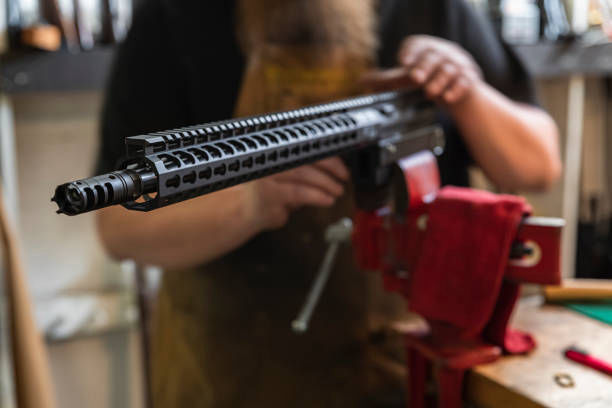In the modern world of firearms and ammunition, few cartridges have gained as much attention and practical versatility as the .300 AAC Blackout, commonly referred to as 300 Blackout or 300 BLK. This cartridge represents an evolution in firearm engineering — a blend of compact power, precision, and adaptability designed to meet the needs of military, law enforcement, hunters, and shooting enthusiasts alike.
The 300 Blackout was developed with a very specific goal: to create a cartridge that could deliver effective ballistic performance from the AR-15 platform, particularly in short-barreled rifles and suppressed firearms, without sacrificing accuracy or reliability. Its combination of subsonic and supersonic performance makes it one of the most versatile modern rifle cartridges available.
This detailed guide explores every aspect of the 300 Blackout, from its origin and ballistic profile to its real-world applications, advantages, and limitations. Whether you are a firearm hobbyist, professional marksman, or simply curious about ammunition design, this article provides a comprehensive understanding of the 300 Blackout cartridge in all its dimensions.
1. The Origin and Development of the 300 Blackout
The .300 AAC Blackout (Advanced Armament Corporation) was officially introduced in 2011, but its conceptual roots go much deeper. The U.S. military had long been seeking a solution that could provide better terminal performance than the standard 5.56x45mm NATO round, especially in short-barreled rifles (SBRs) and suppressed firearms.
Earlier attempts, such as the .300 Whisper developed in the 1990s, had demonstrated the potential of a .30-caliber round functioning in the AR platform. However, the .300 Whisper lacked standardized manufacturing specifications, which prevented it from being widely adopted.
The Advanced Armament Corporation (AAC), in collaboration with Remington Defense, refined the concept to produce a cartridge that:
- Worked reliably in standard AR-15 rifles with only a barrel change,
- Matched or exceeded 7.62x39mm energy levels,
- Functioned both subsonic (for suppressor use) and supersonic (for range and hunting) with minimal modification.
The result was the .300 AAC Blackout, which was approved by SAAMI (Sporting Arms and Ammunition Manufacturers’ Institute) in 2011, ensuring manufacturing consistency and safety standards for mass production.
2. Technical Specifications of 300 Blackout
The 300 Blackout was designed for compatibility and versatility, balancing energy, accuracy, and suppressed performance.
| Specification | Details |
|---|---|
| Cartridge Name | .300 AAC Blackout (300 BLK) |
| Parent Case | .223 Remington / 5.56x45mm NATO |
| Case Type | Rimless, bottleneck |
| Bullet Diameter | 0.308 inches (7.8 mm) |
| Neck Diameter | 0.334 inches |
| Base Diameter | 0.376 inches |
| Case Length | 1.368 inches |
| Overall Length | 2.26 inches |
| Standard Twist Rate | 1:7″ to 1:8″ |
| Primer Type | Small rifle |
| Typical Bullet Weight Range | 110–220 grains |
| Pressure Limit (SAAMI) | 55,000 psi |
These measurements allow the cartridge to function seamlessly in standard AR-15 magazines and bolts, requiring only a change of barrel to switch between 5.56 NATO and 300 Blackout. This level of interchangeability is one of the reasons the cartridge gained such popularity among tactical shooters and firearm enthusiasts.
3. Ballistic Performance and Energy
The ballistic behavior of 300 Blackout varies significantly between supersonic and subsonic ammunition. This dual functionality is one of its most defining features.
| Load Type | Bullet Weight | Velocity (fps) | Energy (ft-lb) | Sound Profile |
|---|---|---|---|---|
| Supersonic | 110–125 grains | 2,200–2,400 | 1,300–1,600 | Louder (without suppressor) |
| Subsonic | 190–220 grains | 950–1,050 | 450–550 | Extremely quiet (with suppressor) |
Supersonic rounds deliver energy comparable to the 7.62x39mm, making them suitable for hunting or mid-range tactical shooting. Meanwhile, subsonic rounds maintain bullet stability below the speed of sound, significantly reducing noise when paired with a suppressor — a crucial factor for stealth and home defense applications.
4. 300 Blackout vs. 5.56 NATO
One of the most frequent comparisons shooters make is between 300 Blackout and 5.56 NATO, given that both can be used in the same AR-15 platform. While 5.56 NATO offers higher velocity and longer range, 300 Blackout provides superior performance in short barrels and suppressed configurations.
| Feature | 300 Blackout | 5.56 NATO |
|---|---|---|
| Bullet Diameter | .308 inch | .224 inch |
| Typical Bullet Weight | 110–220 grains | 55–77 grains |
| Effective Range | 300–500 yards | 500–600 yards |
| Muzzle Velocity | 1,000–2,400 fps | 2,800–3,200 fps |
| Sound with Suppressor | Quieter (especially subsonic) | Louder |
| Short Barrel Efficiency | Excellent | Moderate |
| Terminal Energy | Higher at short range | Higher at long range |
| Recoil | Slightly higher | Lighter |
In summary, 5.56 NATO excels in distance shooting, while 300 Blackout dominates close- to mid-range performance, especially in urban or confined environments.
5. Subsonic vs. Supersonic: The Dual Personality
A unique strength of the 300 Blackout is its dual ballistic profile. Shooters can easily switch between subsonic and supersonic ammunition using the same rifle and magazine.
Subsonic 300 Blackout
- Operates below the speed of sound (1,125 fps or less).
- Ideal for suppressed shooting — extremely quiet with minimal muzzle flash.
- Delivers heavy bullet energy at close range.
- Best suited for home defense or tactical operations.
Supersonic 300 Blackout
- Exceeds the speed of sound (2,000–2,400 fps).
- Produces higher energy and flatter trajectories.
- Effective for hunting and medium-range target shooting.
- Delivers energy similar to 7.62x39mm but with AR-15 accuracy.
Switching between these two types is effortless, offering shooters adaptability unmatched by most modern cartridges.
6. Barrel Length and Suppression Performance
The 300 Blackout was specifically engineered to excel in short-barreled rifles (SBRs). While 5.56 NATO loses substantial energy and velocity in barrels under 14 inches, the 300 Blackout maintains excellent performance even in 9-inch or shorter barrels.
| Barrel Length | Supersonic Velocity (fps) | Subsonic Velocity (fps) | Performance Summary |
|---|---|---|---|
| 16 inches | 2,300 | 1,000 | Maximum velocity and range |
| 10 inches | 2,100 | 980 | Ideal for tactical setups |
| 8 inches | 1,950 | 950 | Great for compact SBRs and suppressed use |
When paired with a quality suppressor, the 300 Blackout becomes one of the quietest and most efficient rifle systems available, producing noise levels comparable to a suppressed 9mm submachine gun while maintaining greater stopping power.
7. Applications of 300 Blackout
The practical uses of the 300 Blackout extend across civilian, military, and professional settings.
a) Home and Personal Defense
The 300 Blackout’s subsonic capability makes it one of the best rounds for home defense when paired with a suppressor. The lower velocity reduces overpenetration risks compared to 5.56 NATO, and the heavier bullet provides strong stopping power within short distances.
b) Hunting
The 300 Blackout is highly effective for medium-sized game such as deer, hogs, and coyotes, especially within 150–200 yards. Supersonic loads deliver deep penetration, while the subsonic option provides quiet and controlled performance in dense environments.
c) Law Enforcement and Military
Special operations and tactical teams often use 300 Blackout for missions requiring stealth, compact weapons, and short engagement ranges. Its compatibility with existing AR platforms allows for seamless integration into standard weapon systems.
d) Recreational and Competitive Shooting
Shooters appreciate the 300 Blackout for its mild recoil, smooth cycling, and versatility in competitions like 3-Gun or tactical rifle events.
8. Advantages of 300 Blackout
| Advantage | Description |
|---|---|
| Versatility | Works with both subsonic and supersonic loads without changing components. |
| Suppressor Compatibility | Excellent performance with reduced sound and flash. |
| Short Barrel Efficiency | Maintains high energy even in compact rifles. |
| AR-15 Compatibility | Uses standard magazines and bolts. |
| Effective Stopping Power | Strong terminal energy at short to medium range. |
| Ease of Reloading | Cases can be formed from common .223 brass. |
This combination of adaptability, stealth, and compatibility makes the 300 Blackout a favorite among those who value efficiency and practicality.
9. Limitations of 300 Blackout
While the 300 Blackout excels in many aspects, it also has limitations:
- Limited Long-Range Capability: The round loses velocity quickly beyond 300–400 yards.
- Higher Ammunition Cost: 300 BLK ammunition can be more expensive than 5.56 NATO.
- Recoil: Slightly higher than 5.56, especially with supersonic loads.
- Confusion Risk: Physically similar to 5.56, improper chambering can cause dangerous malfunctions.
Despite these factors, its benefits often outweigh its drawbacks in the right operational context.
10. Reloading and Ammunition Options
Reloading the 300 Blackout is popular among enthusiasts because cases can be resized from .223/5.56 brass. However, attention to detail is crucial to ensure consistent chambering and safety.
Common bullet options include:
| Bullet Type | Weight (grains) | Best Use |
|---|---|---|
| FMJ (Full Metal Jacket) | 110–147 | Training and target practice |
| Soft Point (SP) | 125–150 | Hunting and defense |
| Hollow Point (HP) | 110–220 | Expansion and stopping power |
| Subsonic Heavy Rounds | 190–220 | Suppressed, stealth applications |
This flexibility allows reloaders to customize performance for different tasks, from quiet backyard shooting to precision hunting.
11. Safety and Maintenance
Because the 300 Blackout shares physical similarities with 5.56 NATO, mixing ammunition poses a serious safety hazard. Chambering a 300 Blackout round in a 5.56 rifle can cause catastrophic firearm damage and injury.
To ensure safety:
- Clearly label magazines and store ammunition separately.
- Use dedicated barrels and markings for 300 BLK rifles.
- Regularly clean the firearm, especially when switching between subsonic and supersonic loads, as carbon buildup can affect suppressor performance.
12. The Future of 300 Blackout
As more shooters recognize the benefits of short-barreled and suppressed firearms, the 300 Blackout’s popularity continues to grow. Manufacturers are developing new bullet technologies, polymer-tipped projectiles, and optimized powders that further enhance accuracy and terminal performance.
The cartridge is now widely used by civilian shooters, hunters, and tactical professionals, cementing its reputation as one of the most innovative modern rifle calibers.
13. Summary Table: Key Points About 300 Blackout
| Aspect | Details |
|---|---|
| Introduced | 2011 (by AAC and Remington) |
| Caliber | .308 inch |
| Compatible Platforms | AR-15, bolt-action, SBRs |
| Performance Types | Subsonic and Supersonic |
| Effective Range | 300–500 yards |
| Suppressor Use | Excellent |
| Best Applications | Defense, hunting, tactical, suppressed shooting |
| Drawbacks | Shorter range, higher ammo cost |
14. Conclusion
The .300 AAC Blackout stands as a remarkable example of innovation in modern firearms engineering. Its creation was driven by the need for a compact, efficient, and versatile cartridge capable of bridging the gap between traditional rifle and pistol calibers. By achieving compatibility with the widely used AR-15 platform while offering both subsonic stealth and supersonic power, the 300 Blackout has carved a permanent place in the world of tactical and sporting firearms.
From home defense to hunting and special operations, the cartridge’s balance of precision, adaptability, and sound suppression makes it an exceptional all-around performer. While it is not a long-range solution, its strength lies in close- to mid-range dominance, where its energy and control truly shine.
As ammunition technology continues to advance, the 300 Blackout will likely remain a go-to choice for shooters who value quiet power, operational flexibility, and compatibility — qualities that few other cartridges can match.
Frequently Asked Questions (FAQs)
1. What is the 300 Blackout designed for?
The 300 Blackout was designed to provide powerful, suppressed performance from short-barreled rifles while maintaining compatibility with the AR-15 platform.
2. Can I use 300 Blackout in a 5.56 rifle?
No. Although the cartridges look similar, using 300 Blackout in a 5.56 chamber is extremely dangerous and can damage the firearm.
3. Is 300 Blackout good for hunting?
Yes. Supersonic loads are effective for medium game like deer or hogs, while subsonic loads are ideal for quiet, close-range shots.
4. How far can a 300 Blackout shoot accurately?
The effective range is approximately 300–500 yards, depending on the ammunition type, barrel length, and shooting conditions.
5. Is 300 Blackout worth it compared to 5.56?
If you value suppressed performance, short-barrel efficiency, and superior close-range power, 300 Blackout is an excellent alternative to 5.56.









